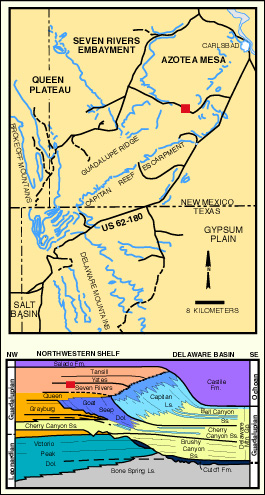
Permian Reef Complex Virtual Field Trip
Stop III-4: Yates-Seven Rivers Lagoonal Facies

Walk down the stream bed to outcrops on north-northwest side of valley (Notice the clasts in the stream; occasionally pyritized halite hoppers can be found). Exposure of thin-bedded, aphanocrystalline to very finely crystalline dolomitic mudstone (see photo) with some zones containing contorted, fenestral mudstone (see photo) representing stromatolitic deposits. In the subsurface much of the fenestral porosity is plugged with anhydrite or gypsum (see photo) and that was true in these beds prior to uplift and dissolution — indeed, many beds exhibit abundant evaporite crystal casts (see photo). Also common, in some zones, are nodular pyritic burrows (largely altered to hematite/limonite). A few beds within these penecontemporaneously dolomitized mudstones contain pellets, peloids (including coated, probably oncolitic grains), gastropods, scarce encrusting foraminifers, and, more commonly, calcispheres. These deposits, with their sparse assemblage of salinity tolerant organisms and evaporite minerals, apparently represent a shallow, hypersaline lagoon similar to those found today in many areas of the Persian Gulf. The coarser beds, which also contain numerous rip-up clasts, may well reflect discrete storm events which have washed material in from more seaward parts of the lagoon and barrier complex.

© Peter A. Scholle, 1999

© Peter A. Scholle, 1999

© Peter A. Scholle, 1999

© Peter A. Scholle, 1999
You should be able to find abundant examples of dissolved, "calcitized" and silicified evaporites at this outcrop. Examine the units above the thick stromatolitic layer with pyritized burrows. Some of these thinner bedded stromatolitic horizons contain abundant black vugs (see photo). The evaporites that once filled the vugs were first partially replaced by euhedral megaquartz (occasionally doubly terminated crystals — Herkimer Diamonds — can be found; Ulmer-Scholle et al., 1993). The megaquartz crystals are black, line the vugs and contain abundant evaporite inclusions (see photo). The black coloration within the crystals is due to abundant, large hydrocarbon inclusions. In fact, the outcrop represents an exhumed oilfield as shown by the presence of residual oil in the pore spaces. Fluid inclusion analyses of both hydrocarbon- and brine-filled inclusions give average temperatures of formation of approximately 67.7°C and 61.7°C, respectively (Ulmer-Scholle et al., 1993).

© Peter A. Scholle, 1999

© Dana Ulmer-Scholle, 1999
The source of the silica was likely the dissolution of detrital feldspars within the back-reef strata. Organic acids associated with the basinal-derived hydrocarbon-bearing fluids increased the silica solubility (Bennett and Siegel, 1987; Bennett et al., 1988). As the hotter hydrocarbon-bearing fluids displaced the cooler, shelf-derived groundwaters, the organic acids broke down, releasing the silica. Quartz precipitated, trapping hydrocarbons inclusions.

© Peter A. Scholle, 1999
Late-stage meteoric water flow associated with Tertiary block faulting was probably responsible for the leaching of the remaining evaporites. Later calcite precipitation resulted in the partial filling of the vugs by late, blocky calcites that overlie residual hydrocarbons in the pores (see photo).
Return to Dark Canyon-Sitting Bull Falls-Rocky Arroyo Roadlog


